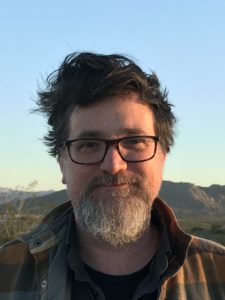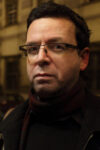
photo credit: Kirsty Singer
In January 2016, a group of armed protestors led by Ammon Bundy occupied Oregon’s Malheur National Wildlife Refuge. The occupation—a curious mix of Mormon millennialism, right-wing grievance, and maudlin YouTube witness—lasted for over a month, and ended with the death of occupier Lavoy Finicum and the arrest of many of the leaders. Anthony McCann’s Shadowlands (Bloomsbury) tells the story of the occupation and the following trials.
Anthony lives in the Mojave Desert, near Joshua Tree. Like his book, he sees the West and its deserts as sites of crucial tension in the American political and ecological imagination. We met in a backyard in Landers, where we spoke about time, God, and the many claims made of and on the land. The second half of the interview can be found here.
Corley Miller: You’ve mostly worked as a poet. How did you come to do such an intensely researched nonfiction project?
Anthony McCann: I was working on this project—a lyrical prose thing—about intimations of time in the desert, and the relationship between different kinds of time, and sovereignty, and for that project I was looking for images of kinds of time in conflict. I guess this one ran away with me.
Where were you headed with desert time?
The project started with a story CA Conrad told to a class at CalArts, where I teach. Conrad had just been at a residency in Marfa, and had gone up to a cave near there full of pictographs—it had been a ritual peyote site was the idea—there were grinding stones and all these images of animal-becoming. Anyone who’s familiar with CA’s work understands that this was a great moment, sitting in the mouth of the cave, but just then this big military drone flies by. What CA said about it was: ‘it was an image of the future.’ But then one of the students cried out, ‘Wait! Stop! What do you mean by the future?’ Which was a great question. That was just as class ended, so we promised to talk about it the next week, but the next week that student was absent and we had other material to cover and we never really picked it up again. But that image stayed with me—the desert, and the cave behind Conrad, and the drone. All of that invokes—for me— messianic time in the sense that Walter Benjamin marked it out—these constellations of the past, meeting the present. I found myself describing the image to friends, asking what about it was so compelling, and people kept pointing out that in that image it’s not clear which way is forward and which way is back. What’s the past, what’s the future?
And then, people who lived in the desert kept hitting on another thing—in the desert all machines are future junk, heaps of rust you’ll find out in a sun bleached basin. There’s something about the desert—everything becomes ruins out here, or seems to. Which also points to that time confusion. So I wanted to do a book that was a series of meditations on images of the Now, images like this. A very different book! But then Ammon Bundy happened, and the takeover of the refuge was one of these images. New images were coming every day—which also happened to be “current events.” Then I went up there—specifically to talk to the folks in the Burns-Paiute tribe, who were offering a very different vision of the desert and time, and whose 19th century history offered some very different notions of messianic time (with the earth, not a transcendent abstraction, in the role of redeemer). Anyway, all that led to all sorts of conversations and then to the trials and on and on and that all became this book.
So much of what the book sees in Malheur is collisions between different conceptions of time, especially between the occupiers and the local Paiutes.
Specifically what they think a long time is.
Where does Ammon Bundy get his idea of time?
For the Bundys it goes back to Mormon time. One of the things that Joseph Smith did successfully—he was in a new country, and there was a huge thirst to connect this new country to some kind of archaeological, biblical past. And it’s not like he was some far-out loony with this idea. Smith grew up in Western New York, after his family had moved from Vermont, and there were all these burial mounds out there. Even Governor DeWitt Clinton of NY had written about how these mounds couldn’t have been built by ancestors of the Native neighbors that white folks alternately fetishized and feared and loathed. So Smith—starting off writing what it seems was meant to be a work of found fiction (the golden tablets of the Book of Mormon he claimed to have found in the hill of Cumorah)—created a whole white New World Dispensation, where all the holy dispensations of the West were gathered into completion. Ammon also works with this idea that what’s happening right now in our political life is profoundly related to—in his case—the full realization of Christian time—which is also the completion of the work of the Constitution.
It’s strange how much work this idea has to do to sustain the prejudice—it would be much easier to just accept that there were other people here before and they did the burial mounds. But instead you end up inventing this whole biblical timeframe just to keep thinking your people are the chosen people.
Smith uses a key phrase from Ephesians about this time being ‘the dispensation of the fullness of time’ – which would be the time when all the times and all of the previous dispensations are gathered into one, to return and finally come true. The faith of the Latter Day Saints holds, more or less, that that ending time has begun. Or began in the 19th century. And it has this connection to the American Earth specifically, in terms of Smith digging up these tablets of the Book of Mormon, which he claimed to have found right there in the American dirt. So that faith is also a geography, an American geography, a white one, and also an American time, which is coming to a culmination. It’s all coming to a culmination—I think in the occupation you could always feel that conception of time. In Ammon’s New Years 2016 video address to his followers, where he invites them to join him in a big action in Oregon the next day, he says ‘come see the wonderful thing the lord is about to accomplish.’ There’s this feeling that all of time is pouring through and to this moment. Even for people who aren’t deeply Christian or Mormon, that idea’s full of messianic power. ‘This is the time, this is the place, and you are the people.’ But it’s a much different conception of time from the traditionalist Paiute conception, which is expansive, rather than narrowing—a sense of time which is a series of earthly relationships that move forward and back in all directions.
Could an occupation with that notion of messianic time have ever stopped without someone dying?
It’s hard to imagine. In the logic of Christian time, there has to be an event in order to usher in what comes after. And it has to be a death or a pain ceremony that brings that abstraction into the body, so that a new dispensation or a new phase can begin in some way. So it does feel that something like that had to happen. And it had that feel even before LaVoy Finicum met his end up there in the Malheur National Forest.
Both the Christian and American origin stories have a lot of blood.
The whole time I was working on the book I kept singing ‘Highway 61 Revisited’ to myself. There was this sacrificial logic to the whole thing, and at the same time this American comedy. We’ll just throw some bleachers out in the sun. That’s the kind of meaning they were making. But that messianic time also develops an intense sense of community. It was strange talking to these people—the occupiers and their supporters—because they come from this individualist super-libertarian culture, but the big takeaway for a lot of them was this feeling of oneness and community. And that too is messianic time—especially when they felt, as they did, that at any moment they might all be killed. They felt that these really might literally be, for them, the final days, the time that remains.
For an occupation initially conceived as a property rights protest, it’s odd how everyone ends up so moved by the chance to live in community.
A lot of these individualists, these Ron Paul libertarians, come out of spaces in the Intermountain West where community has always been threadbare, but has now been particularly devastated. Places where there had been some kind of extractive economic sustenance, which sustained a public sphere of some kind. But not anymore, or not so much, in a lot of these places. From that perspective it makes sense that community would be something they primarily valued about it—sometimes they sounded like people I know who had felt rhapsodic about Occupy Wall Street. It was uncanny.
Is there a connection between that messianic conception of time and living in the West?
The Bundys come from a Mojave Desert Latter Day Saint community that was founded in the 19th century as an experiment in total, communitarian living. The idea was to share everything in anticipation of the culmination of time. Obviously that family is now known as defenders of a much different notion of property. But even today they’re out there on horseback, out there in the desert every day, and the stories that they bring to understand everything—time and themselves and the earth—are these epic, theological narratives that seem to me to suit the grandeur and loneliness and temporal and spatial vastness of the Mojave Desert, where I live as well. Just think of geologic time—the desert gives me a chance to think of that everyday, not just to think it, but feel its realities. The Bundys don’t think along these secular lines really, but their times are also vast, if limited to a tiny human scale. And within that holy landscape and timescape it’s easy to understand how you could come to understand your own intimations and inspirations as the whisperings of the divine.
Maybe you tend to promote yourself to the size of the space?
There’s a real grandeur in that family. I mean, Cliven Bundy—Las Vegas was going to cap-and-trade him out of existence. It started in the early 90s with the federal listing of the desert tortoise as an endangered species. There were a couple dozen ranching families out there by the Bundys, and almost all the others took deals and went out of business. It’s a marginal business at best. Ranching on public lands in the desert? The amount of land you need to use? It’s insane the amount of debt most of those folks carry. Most often they’re barely making it. And then someone says you can’t run as many cows, or you have to take the cows off during the green-up, which is when there’s the most to eat? All because of the desert tortoise—which in your worldview is a critter that human beings have priority and dominion over? You can’t run cows on just your one hundred sixty acres—you need that public land. So their decision was really existential to their minds—go out of business or don’t. But here’s where the messianic time came in: Cliven didn’t just say, ‘this isn’t fair.’ He said something to this effect, or this is how I would translate it: ‘We have discovered your entire world is illegal. Because we understand the word of God as it is revealed in the Constitution. And we understand that it is our role to stand in the defense of that Constitution as part of our own spiritual growth.” And unlike their rancher neighbors they are still there. They stood up to so much power on the strength of that holy desert grandiosity. Of course that grandiosity seems to mean they can’t notice anything but the federal government. Even though Las Vegas and Clark County and a lot of real estate money had a lot to do with it too, with the deal that was cut to make the Bundy zone a special tortoise protection zone so that the city could keep on booming, and developers could keep paving over habitat. Which meant moving and even sometimes killing tortoises.
They don’t seem to have a lot of room for middle ground.
Ryan Bundy ran for governor of Nevada last year, as an independent. Because to him both Democrats and Republicans betray the people of Nevada, who need to become sovereign over their own land. Someone asked him if he would compromise. Ryan said something like ‘compromise is a terrible word. Why would you compromise your principles? That’s not what principles are for.’ So there’s not much middle ground for them.
Which comes up again in their disinterest about or blindness to corporate power. You want to ask them, if the federal government transfers or sells off the public land of Nevada and the rest of the west, who’s going to get it? It’s not the individual, small time ranchers. It’s going to end up largely in the hands of huge private interests who have already been buying up huge chunks of the west. Because the states are going to auction that land off in a lot of cases. But the Bundys tend to fill most complex middle grounds with faith and principles. For example, just the idea that land might be managed for the benefit of non-human creatures is anathema to them. That this would be of value is incomprehensible. It’s more like a sin to someone like Ryan Bundy. Ryan explained this to me: his life here is just an earthly sojourn. “We believe”, he told me, “that we existed before this life, as spirits, as intelligences, that we dwelt with him in a premortal realm. It was his design that we should progress to become more like him. We needed to have a body and experience mortal life and that’s what this mortal life is: we are spiritual beings that are here on earth having a mortal experience. When you view yourself as a child of god, you begin to have a different perspective.” That’s what the earth is for in their vision—it’s for humans, for the purpose of the completion of that earthly sojourn. So the idea that public land wouldn’t be put to maximum human use becomes anathema.
Which is a strange ecological idea for someone who works so closely on the land.
It’s a very instrumentalized ecology. It’s literally: ‘God gave man dominion over everything.’ It’s sovereignty. You’re being given dominion so that you might make the right choices with that. And as Ryan explains it, that’s also why you can’t have land preservation. You can’t conserve it for non-human use because that’s not part of the test. The idea that you could prioritize the survival in the wild of the marvelous desert tortoise—for example—becomes an abomination.
Corley Miller is a writer living in Los Angeles. His fiction, nonfiction, and criticism has appeared or is forthcoming in The Guardian, The New Republic, Vice, the Los Angeles Review of Books, and n+1, among others.
This post may contain affiliate links.







